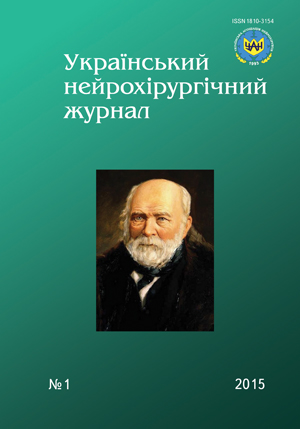The experience of stereotactic aspiration in treatment of brain abscesses
DOI:
https://doi.org/10.25305/unj.42397Keywords:
brain abscess, neuroinfection, stereotactic aspirationAbstract
Purpose. To estimate efficiency of stereotactic aspiration of intracerebral abscesses in deep and functionally eloquent brain areas.
Methods. 12 patients with brain abscesses who underwent stereotactic aspiration were included into the study. Stereotactic interventions were performed using CRW Radionics Stereotactic System with StereoFusion, StereoPlan (Radionics) and FraimLink (Medtronic) software for target definition. Postoperative follow-up was from 1 to 36 months, in average (14±3.6) months.
Results. During surgery in 11 (91.7%) patients pus was evacuated from abscess cavity, in 1 (8.3%) — late cerebritis was defined. There were no complications, all patients are alive. 3 months after surgery neurological symptoms regressed in 9 (75%) patients, in 2 (16.7%) — permanent neurological deficit preserved.
Conclusions. Stereotactic aspiration is an effective and safe method of surgical treatment of brain abscesses. It could be the therapy of choice over open surgery because it is less invasive, thus reducing likelihood of neurological complications.
References
Muzumdar D. Central nervous system infections and the neurosurgeon: A perspective. International Journal of Surgery. 2011;9(2):113-116. CrossRef
Taub E, Lozano A. Image-Guided Management of Brain Abscess. Textbook of Stereotactic and Functional Neurosurgery. 2009:769-777. CrossRef
Menon S, Bharadwaj R, Chowdhary A, Kaundinya D, Palande D. Current epidemiology of intracranial abscesses: a prospective 5 year study. Journal of Medical Microbiology. 2008;57(10):1259-1268. CrossRef
Mathisen G, Johnson J. Brain Abscess. Clinical Infectious Diseases. 1997;25(4):763-779. CrossRef
Nathoo N, Nadvi S, Narotam P, van Dellen J. Brain Abscess: Management and Outcome Analysis of a Computed Tomography Era Experience with 973 Patients. World Neurosurgery. 2011;75(5-6):716-726. CrossRef
Kumar A, Saeed H, Alamri A, Crocker M, Dave J. Twenty years of intracranial abscesses: prognostic indicators and treatment review. Journal of Infection. 2011;63(6):491-492. CrossRef
Muzumdar D, Jhawar S, Goel A. Brain abscess: An overview. International Journal of Surgery. 2011;9(2):136-144. CrossRef
Moorthy R, Rajshekhar V. Management of brain abscess: an overview. Neurosurgical FOCUS. 2008;24(6):E3. CrossRef
Mace S. Central Nervous System Infections as a Cause of an Altered Mental Status? What is the Pathogen Growing in Your Central Nervous System?. Emergency Medicine Clinics of North America. 2010;28(3):535-570. CrossRef
Korniyenko VN, Pronin IN. Diagnosticheskaya neyroradiologiya [Diagnostic Neuroradiology]. Moscow:: IP T.M. Andreyeva, 2009. Russian.
Haimes AB, Zimmerman RD, Morgello S, Weingarten K, Becker RD, Jennis R, Deck MD. MR imaging of brain abscesses. American Journal of Roentgenology. 1989;152(5):1073-1085. CrossRef
Stone J, Hockley A. Percivall Pott and the Miners of Cornwall. Br J Neurosurg. 2002;16(5):501-506. CrossRef
Morand S. Opuscules De Chirurgie. Paris; 1768.
Macewen W, Schlesinger E. Pyogenic Infective Diseases Of The Brain And Spinal Cord. Glasgow: Maclehose; 1893.
Canale D. William Macewen and the treatment of brain abscesses: revisited after one hundred years. Journal of Neurosurgery. 1996;84(1):133-142. CrossRef
Dandy W. Treatment of chronic abscess of the brain by tapping. Journal of the American Medical Association. 1926;87(18):1477. CrossRef
Mut M, Hazer B, Narin F, Akalan N, Ozgen T. Aspiration or capsule excision? Analysis of treatment results for brain abscesses at single institute. Turk Neurosurg. 2009 Jan;19(1):36-41.
Sarmast AH, Showkat HI, Kirmani AR, Bhat AR, Patloo AM, Ahmad SR, Khan OM. Aspiration versus excision: a single center experience of forty-seven patients with brain abscess over 10 years. Neurol Med Chir(Tokyo). 2012;52(10):724-730. CrossRef
Jennet B. Assessment of outcome after several brain damage. A Practical Scale. The Lancet. 1975;305(7905):480-484. CrossRef
Mintser OP, Voronenko YUV, Vlasov VV. Obroblennya klinichnykh i eksperymental'nykh danykh u medytsyni [Processing of clinical and experimental data in medicine]. Kiev: Vyshcha shkola, 2003. Ukrainian.
Auffray-Calvier E, Toulgoat F, Daumas-Duport B, Lintia Gaultier A, Desal H. Infectious and metabolic brain imaging. Diagnostic and Interventional Imaging. 2012;93(12):911-934. CrossRef
Downloads
Published
How to Cite
Issue
Section
License
Copyright (c) 2015 Iaroslav Zinkevych, Konstantin Kostiuk, Oleksandr Glavatskyi, Andrii Bolіukh, Tatyana Malysheva, Irina Tkachik, Vitaliy Tsymbaliuk

This work is licensed under a Creative Commons Attribution 4.0 International License.
Ukrainian Neurosurgical Journal abides by the CREATIVE COMMONS copyright rights and permissions for open access journals.
Authors, who are published in this Journal, agree to the following conditions:
1. The authors reserve the right to authorship of the work and pass the first publication right of this work to the Journal under the terms of Creative Commons Attribution License, which allows others to freely distribute the published research with the obligatory reference to the authors of the original work and the first publication of the work in this Journal.
2. The authors have the right to conclude separate supplement agreements that relate to non-exclusive work distribution in the form of which it has been published by the Journal (for example, to upload the work to the online storage of the Journal or publish it as part of a monograph), provided that the reference to the first publication of the work in this Journal is included.









